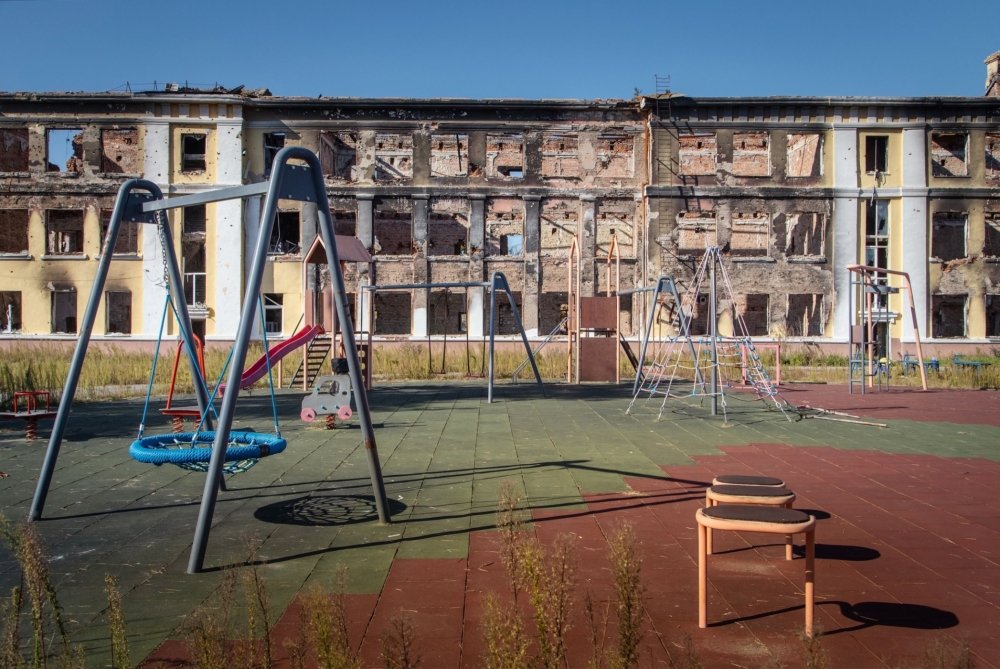
A blog of the Kennan Institute
The Impact of War on Ukraine’s Youth and Workforce Development
On September 2, the school year began in Ukraine, marking the third consecutive year in which children have had to study under the conditions of a war that began with Russia's invasion, in February 2022. Nearly 600,000 children in Ukraine receive their education remotely, and more than 390,000 Ukrainian children abroad continue their studies through online programs provided by Ukrainian schools. As the war continues, these schools face the complex challenge of ensuring that all children can access their right to education.
Wartime Education Formats
According to the Ministry of Education and Science of Ukraine, face-to-face education, with the possibility of incorporating a blended learning model, remains the priority for Ukrainian schools. This policy approach combines in-person classes with distance learning. However, schools must meet several criteria to implement this blended format. Under martial law, educational institutions must have bomb shelters or other protective structures within the school or no more than 500 meters away. Schools must be equipped with the necessary material and technical resources to support this type of instruction. If these conditions are not met, distance learning is mandated.
Distance learning, which became widespread during the COVID-19 pandemic, is also available for children living in temporarily occupied territories. In some cases, where security conditions allow, an individual program can be provided.
Displaced Students
The number of Ukrainian students enrolled in schools across Europe varies, depending on the source. European Commissioner for Internal Affairs Ylva Johansson estimates that around 450,000 Ukrainian children are currently attending European schools. In contrast, Ukraine's educational ombudsman reports that about 800,000 children were integrated into the EU school system during the 2022–23 academic year. The European Commission cites approximately 700,000 displaced Ukrainian children enrolled in schools across the EU. Whichever figure is correct, they all signal the fact that huge numbers of Ukrainian pupils have left their country of origin.
Many Ukrainian children continue their education online, with Ukrainian teachers providing remote instruction, which has become a lifeline for these students.
Infrastructure Challenges and Safety
Ukrainian children living in war zones, particularly those on the front lines, face significant challenges in accessing education. One major issue is the reintegration of territories that were under Russian occupation and have since been liberated by the Ukrainian Armed Forces. According to sociological surveys, the reconstruction in these de-occupied areas is still in its early stages, with efforts focused on meeting immediate survival needs rather than getting children back in school buildings.
For example, in Kharkiv, residents rate the reconstruction of their communities at an average of 7 out of 10 in one survey, while in Kherson, the rating is lower, at 5.5. This difference reflects the varying degrees of progress in rebuilding efforts, which directly impact the educational opportunities available to children. In Kharkiv, 200 first-graders are attending the first underground school built in the Industrial District, with a total of 1,100 children expected to attend in two shifts. Children in the liberated parts of the Kherson region face greater difficulties in accessing education.
The public’s perception of reconstruction efforts, including educational infrastructure, is closely tied to its trust in the government. Sociological surveys indicate that larger cities, where there is a more active civil society, tend to have more criticism of government efforts, with concerns about inefficiency, corruption, and slow responses to challenges. A recent survey shows that the majority of Ukrainians distrust state institutions, with 78.5% expressing distrust in government officials, 77.5% in political parties, and 76% in the parliament. Local authorities fare somewhat better, with only 39% expressing distrust in them.
Another critical challenge for children in Ukraine is mine safety awareness and the adoption of safe behavior practices. The results of the most comprehensive study in Ukraine on awareness and behavioral models among children and their parents reveal that dangerous behavior is more common among boys from communities where the land is heavily mined. Boys between 14 and 17 are particularly at high risk for engaging in unsafe behavior related to unexploded ordnance. Over 90% of the children surveyed stated that they had been informed about mine safety rules. However, high awareness does not necessarily equate to safe behavior.
Labor Needs
The challenges faced by Ukrainian children today will have a profound impact on the nation’s future, particularly in terms of labor resources for postwar reconstruction. A recent survey highlights the current shortage of labor resources in Ukraine, with 66% of men and 55% of women reporting a deficit in both qualified and unqualified professionals across all competences. Among survey respondents, 30% reported a significant shortage of professionals across the board, with 24% noting a lack of qualified specialists. This shortage is not only a current challenge but also a future one, as the children who are now experiencing disrupted educations and dangerous living conditions may face difficulties in acquiring the skills needed for Ukraine’s reconstruction.
Addressing the labor shortage will require a multifaceted approach. Over half of the survey respondents (54%) believe that retraining employees and redistributing responsibilities within the workforce is essential; 52% of them believe it is important to expand programs to attract young professionals and encourage the return of Ukrainian citizens currently residing abroad.
Conclusion
The intersection of education challenges and labor resource needs highlights the importance of strategic investments in both areas. Ensuring that children in war-torn regions receive not only education but also safety training is crucial for their development into skilled and responsible adults who can contribute to Ukraine's reconstruction. At the same time, addressing the current and future labor shortages through retraining, inclusive workforce policies, and automation will be the key to building a resilient economy. The future of Ukraine depends on how effectively these challenges are met today, ensuring that the next generation is prepared to rebuild and thrive in a postwar society.
The opinions expressed in this article are those solely of the author and do not reflect the views of the Kennan Institute.
See our newest content first.
Subscribe to receive the latest analysis from Focus Ukraine.
About the Author

Kateryna Odarchenko
Kateryna Odarchenko is a political consultant, a partner of the SIC Group Ukraine, and a member of the International Association of Political Consultants (IAPC).
Read More
Kennan Institute
The Kennan Institute is the premier US center for advanced research on Eurasia and the oldest and largest regional program at the Woodrow Wilson International Center for Scholars. The Kennan Institute is committed to improving American understanding of Russia, Ukraine, Central Asia, the South Caucasus, and the surrounding region though research and exchange. Read more












